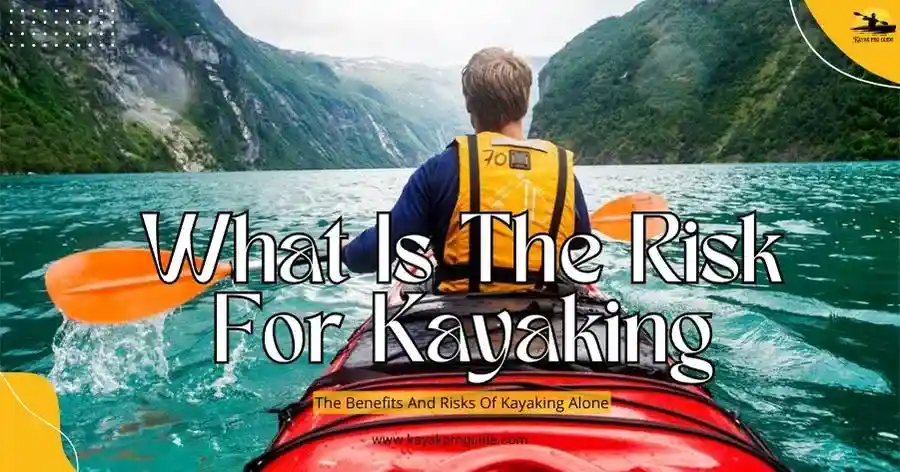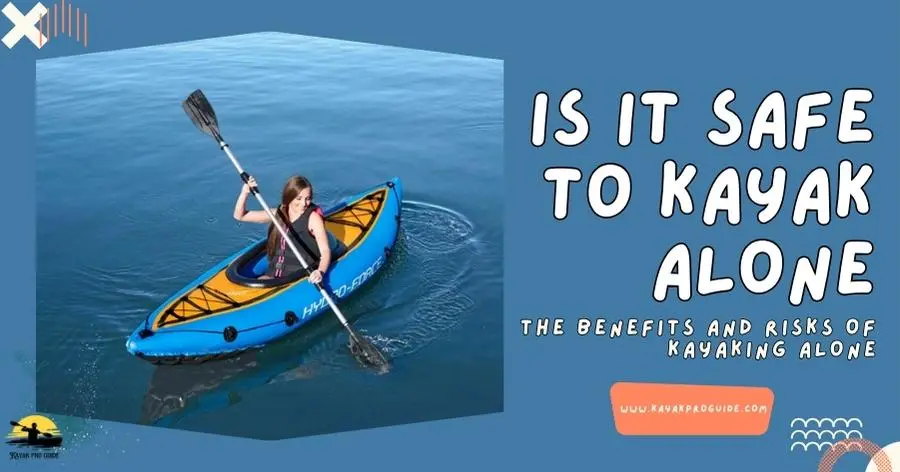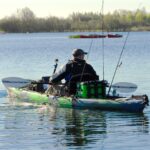In general, kayaking is a popular outdoor activity that provides a perfect mixture of adventure and tranquility.
Although you are experienced, enthusiastic, or skilled in sport, the question of protection is always a top priority. After that, many kayers think about the idea of navigating water without companionship.
For this reason, this is something that invites the mind and the debate. Because the temptation of single kayaking is unacceptable, the anxiety of protection is greater.
Therefore, on this blog today, I will try to inform you: Is It Safe To Kayak Alone? I will explore the various reasons for contributing to the protection.
Thus, from situation awareness to preparation, I will solve the necessary considerations for the thinking of a single kayak adventure.
Can I Carry a Kayak by Myself?
You can carry a kayak yourself. But it depends on the size of the kayak, weight, your physical strength, and the environment. Here are some things to consider:
Generally, small, light kayaks are more accessible to carry than large, heavy kayaks. Usually, a single person can easily carry up to a 12-foot, 30-pound kayak.
Moreover, your strength, endurance, and experience affect your ability to carry kayaks. As a result, it will be easier for regular exercises to carry kayaks.
Also, in flat, bright places, carrying kayaks is easier than in rough areas. Thus, carrying kayaks in the air or slope area can be more difficult.
Is It Safe To Kayak With No Experience?
It depends a lot on your experience exactly how safe kayaking is. You may be thinking, Is It Safe To Kayak Alone
Basically, it depends entirely on your experience. However, it is possible to go kayaking even if you have no experience.
But, it is essential that you understand the risks and take steps to reduce them:
1. Understand The risk:
Do not read the use of security equipment. For example, life jackets, sunscreen, water, and a city should always be worn to shout. Avoid inappropriate weather conditions, bad weather, strong waves, or stormy winds.
Be aware of the water that you are doing in the body of the unknown area. Especially the tidal, the stools, and the other obstacles.
Next, it is not good to have extra confidence. Therefore, know your limitations and do not go too far or out of your experience.
2. Tips To Reduce Risk:
- First, if you are not experienced, it is best to go kayaking with someone who is experienced.
- Second, many kayaking courses and guides are available that can teach you the basic rules and security methods.
- Third, start from the quiet area. It is better to start kayaking from an area with fixed water or small waves.
- Fourth, wear appropriate clothing. For example, wear life jackets, sunscreen, hat and swimwear.
- Fifth, keep the means of contact. Keep a cell phone or other contact device so you can call for help.
- Sixth, check the weather. Always check the weather before going, hence, kayaking and avoid bad weather.
- Seven, come back soon if you feel tired, cold, or uncomfortable.
Thus, kayaking can be a great experience. It is important, however, that you understand the risks and take steps to stay safe.
Although even if there is no experience, kayaking can be done, it must be done with plan, preparation, and caution.
What Is The Risk For Kayaking?
Kayaking can be a great experience, but it is not at risk -free. As a result, it should be understood that your experience, environment, and other factors determine the risk level.

Let’s see a few general risks:
Generally, drowning is the most serious risk of kayaking. Wearing a life jacket, of course. Then, if submerged in cold water, the body temperature may decrease rapidly, which can cause death.
Carefully keep dry clothing and be careful in cold weather. Next, wear sunscreen to protect yourself from the sun’s rays.
Further, collision with waves or collision with other kayaks can cause accidents. Be careful and maintain a safe distance from other kayaks.
Is Kayaking Hard?
How challenging kayaking is depends on your experience, physical fitness, and environment. Is it safe to kayak alone for you?
However, in general, it is relatively easy to start, and most people can enjoy it after some practice:
1. Why it Can Be Easy
Basically, no need to stand in kayaking, you can sit comfortably. It makes it especially comfortable for long water trips.
Next, learning basic kayaking techniques is relatively easy to learn, kayaking uses your whole body, which makes it a great way to exercise.
2. Why it Can Be Difficult:
Overall, if you are not accustomed to the strange position of kayaking, you may first feel a bit uncomfortable. However, if your muscles get used to it, it will become comfortable.
Also, bad weather, like wind or storm, can make kayaking more difficult. In this case, long-distance kayaking can make your muscles tired. Especially if you are not accustomed to it. It is essential to start slowly and take a break.
Tips For First Time Kayakers
Congratulations, you are about to enjoy the great experience of kayaking.
For the first time, there are a few tips for kayaking that will make your experience more pleasing:
- Take training
- Choose the appropriate kayak
- Start from the quiet environment
- Always wear a life jacket
- Keep with security equipment
- Know your limitations
- Go with someone experienced
- Put cell phone for safety
- Check the weather
- Rest
Thus, rejoice kayaking is a great way to explore nature and feel freedom over water. Relax, have fun, and enjoy this great experience.
What Are The Benefits Of Kayaking?
Kayaking is not just a great experience, it also benefits many benefits for your mental and physical health. But the fear is that Is It Safe To Kayak Alone.

It depends on your experience, though. Let’s see a few important benefits:
1. Physical Health
Kayaking strengthens your heart, lungs, and muscles. This can be a great cardio workout that can improve your overall fitness.
Kayaking uses different muscles, including your arm, back, core, and foot. It can increase your strength and endurance. Kayaking is a calorie-burning activity that can help you lose weight.
2. Mental Health
- Reduce stress
- Mentalization
- Increase
- Social interaction
3. Additional benefits
- Connecting with nature
- Explore new places
- Fun and entertain
In this manner, overall, kayaking has many benefits for your physical and mental health. This is a great way to improve fitness, connect with nature, and have fun.
What Are The Risks of Kayaking Alone?
Is It Safe To Kayak Alone? Although it is thrilling to kayaking, there are many risks. Especially if you are kayaking in the canals of different sections of the USA:
The boat can turn upside down in sudden circumstances such as the waves, the loss of balance, or the storm.
Especially if alone, it is difficult to get help. As a result, not knowing how to swim, not wearing a life jacket properly, or pulling muscles increases the risk of drowning for multiple reasons.
The USA has aquatic animals like mud, snakes, and poisonous fish in different regions. It is difficult to prevent those who can attack, especially if alone.
Thus, to avoid these risks, kayak in groups, wear life jackets, swim, monitor the weather, and consult locals. Be safe by yourself, and keep the family relaxed.
Frequently Asked Questions (FAQs)
What is the risk for kayaking?
Too much risk. Particularly in the waves of the waves, the boat is at risk of overturning, drowning, or attacking aquatic animals.
Is kayaking hard on the body?
Kayaking is not difficult at the beginning. This is a low-impact exercise, but there is a risk of muscle to catch.
Can a woman carry a kayak?
Of course, modern kayaks are lighter and easier to carry. Many women carry themselves in the car alone. But depends on the size of the kayak and your physical strength.
Related Post
Can You Paint A Kayak
How To Inflate An Inflatable Kayak
Can You Put A Pedal Drive On Any Kayak
How To Protect Phone While Kayaking
Can Fat People Go Kayaking
Bottom Line About Is It Safe To Kayak Alone?
Although alone, kayaking can be a pure and fruitful experience. However, it is essential to prioritize everything else on everything else.
However, always inform someone about your planned route and expected return time. For this reason, wear a personal flotation device and carry the necessary security gear, such as a whistle and a contact device.
Therefore, consider taking the Kayaking Protection Course to additionally enhance your skills and knowledge.
In this manner, with this caution, you can enjoy the tranquility of single kayaking while reducing the risk. Always remember, protection is first, adventure second.












